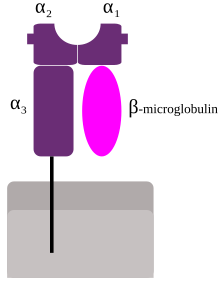
Back معقد التوافق النسيجي الكبير القسم 1 Arabic MHC glykoprotein I. třídy Czech Complejo mayor de histocompatibilidad de clase I Spanish مجموعه سازگاری بافتی اصلی کلاس یک Persian Complexe majeur d'histocompatibilité de classe I French MHC de clase I Galician MHC-I Italian MHCクラスI分子 Japanese MHC klasy I Polish ГКГС класу I Ukrainian
| MHC class I | |
|---|---|
 Schematic representation of MHC class I | |
| Identifiers | |
| Symbol | MHC class I |
| Membranome | 63 |
MHC class I molecules are one of two primary classes of major histocompatibility complex (MHC) molecules (the other being MHC class II) and are found on the cell surface of all nucleated cells in the bodies of vertebrates.[1][2] They also occur on platelets, but not on red blood cells. Their function is to display peptide fragments of proteins from within the cell to cytotoxic T cells; this will trigger an immediate response from the immune system against a particular non-self antigen displayed with the help of an MHC class I protein. Because MHC class I molecules present peptides derived from cytosolic proteins, the pathway of MHC class I presentation is often called cytosolic or endogenous pathway.[3]
In humans, the HLAs corresponding to MHC class I are HLA-A, HLA-B, and HLA-C.
- ^ Hewitt EW (October 2003). "The MHC class I antigen presentation pathway: strategies for viral immune evasion". Immunology. 110 (2): 163–9. doi:10.1046/j.1365-2567.2003.01738.x. PMC 1783040. PMID 14511229.
- ^ Kulski JK, Shiina T, Anzai T, Kohara S, Inoko H (December 2002). "Comparative genomic analysis of the MHC: the evolution of class I duplication blocks, diversity and complexity from shark to man". Immunological Reviews. 190: 95–122. doi:10.1034/j.1600-065x.2002.19008.x. PMID 12493009. S2CID 41765680.
- ^ http://users.rcn.com/jkimball.ma.ultranet/BiologyPages/H/HLA.html#Class_I_Histocompatibility_Molecules Archived 2016-02-04 at the Wayback Machine Kimball's Biology Pages, Histocompatibility Molecules
© MMXXIII Rich X Search. We shall prevail. All rights reserved. Rich X Search